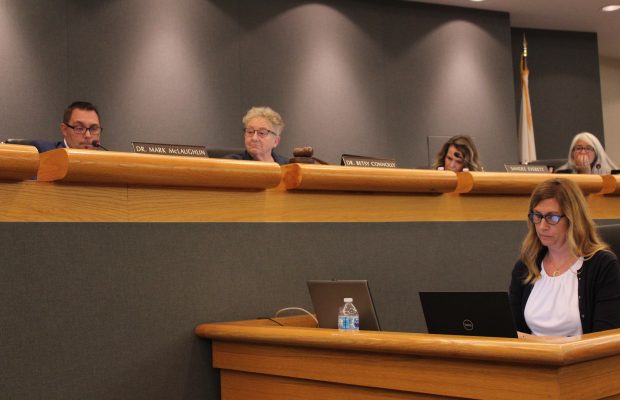PPP raises community discussion

The district is in the process of adopting new health curriculum to meet the updated state guidelines, which is bringing multiple community members to the recent CVUSD school board meetings to express their support and concerns. No curriculum has been adopted at this time, but the district recognizes the need to include curriculum that covers gender identity and awareness of transgender and LGBTQ+ students to not only meet the state standards but to meet the community’s needs as well.
At the recent school board meeting on Nov. 5, multiple community members expressed concern regarding new health curriculum options that the school board may choose from, one of them being Positive Prevention Plus (PPP).
Several parents encouraged the board to add awareness and inclusion of LGBTQ+ children in elementary classes. Megan Goebel is a mother of a transgender elementary age student in the CVUSD district and is passionate about the inclusion of LGBTQ+ in schools. “My transgender child isn’t the first, nor the only and most definitely will not be the last to come through our elementary schools. Therefore, the earlier we start educating our kids about all differences, including this one, the better chance we have at normalizing this topic and get back to just letting kids be kids,” Goebel said.
While Goebel was one of many parents sharing personal experiences with loved ones who are transgender, they were met with opposition from religious persons who felt incorporating gender identity, LGBTQ+, and transgender awareness went against their personal beliefs and should be left out of the classroom. Public speakers in opposition of sexual education in the district quoted pages from Positive Prevention Plus and other curriculum even though CVUSD has not reviewed any material yet.
Peggy Rosenburg, a concerned grandmother who cited curriculum specifically from PPP in public comments stated the content is graphic and goes against her religion. “Positive Prevention Plus teaches minors how to develop sexuality before maturity, [teaches] minors that sex is primarily self-gratifying without citing the legal ramifications of sex with minors, and using graphic illustrations that would be considered pornographic elsewhere… There’s no pedagogical reason to support the teaching of Positive Prevention Plus that are in opposition to the practices to the protected class of religion,” Rosenburg said.
Another speaker who only gave her first name, Charlene, described herself as a “God fearing person” who accepts everyone. She feels “education does not belong in an elementary school because the kids don’t know the difference. When you open up that difference to them, they’ll have a bucket of why should I and shouldn’t I. Leave it alone and let them just be kids,” she said.
Positive Prevention Plus was a curriculum proposed by the Ventura County Board of Education to teach sexual health, teen pregnancy prevention and HIV and STD prevention. This curriculum includes education on LGBTQ+ and teaches gender identity in grades K-5. Many health teachers in the district have been trained to teach PPP. Surrounding districts have considered the curriculum’s integration and while it has not yet been reviewed by CVUSD, it might be as well as several other curriculums to fit the new mandated state framework. According to the district’s website, “CVUSD administration and teachers will be reviewing the new requirements passed by AB 329 and the recently approved CA Health Education Framework to identify appropriate supplemental materials to be approved by the board of education.”
Over the months the board has mentioned their consideration of Positive Prevention Plus. During the Aug. 20 meeting, Dr. Mark McLaughlin, superintendent, said that the curriculum is open to change but has not changed as of yet. “We have not brought any (K-5) curriculum such as presented at the podium right here to be approved by our board of education at this time,” McLaughlin said.
Up until August 2019, the CVUSD Health Education website page stated, “CVUSD has no plans to adopt K-6 gender diversity materials. These K-6 materials are not mandated under AB 329.” On Oct. 24, the response was updated to: “However, since the 2019-2020 school year has been in session, the district has recognized a growing need to provide support to transgender students, their parents/guardians, and school staff. Therefore, district staff is currently researching best practices to ensure all students have a safe and supportive learning environment.”
Currently, the curriculum used by CVUSD is from the Glencoe Health textbook, integrated in 2004 and published in 2005. Sexual education unit is included in three chapters of the book and is about 20 pages long.
According to Lynn Baum, health teacher, the health course teaches reproduction, love, Sexually Transmitted Diseases (STDs) and birth control.
“We cover the reproductive system, the stages that the fetus goes through, the stages of labor, the development of the fetus and then we also talk about what a healthy relationship looks like. We talk about STDs, or STIs as they’re called. And we talk about birth control that you would protect yourself with. We talked about abstinence being the best choice for teens at this point in their life,” Baum said.
The staff was trained in PPP three years ago, but the curriculum has yet to be integrated into the health course. “It has to be voted on by the family life committee and voted on the school board. So that’s going through the school board right now, on what they’re going to adopt or what they’re not, but we all the health teachers got together last year and worked on the curriculum, what we want to include, and now it’s up to the district to approve it or not,” Baum said.
The board also addressed the new 2019 Health Education Framework for California Public Schools, the health curriculum guideline released by the California Department of Education, which included new lessons on LGBT and gender identity issues. School board president Betsy Connolly stated the school board is trying to keep up with the law.
“I think we need to wait to have a comprehensive discussion rather than accept suggestions from community members who want to insert clauses into our policies one by one or nibble at our policies bit by bit,” Connolly said.



